| Советские гитары :: Форумы :: Articles :: Electric guitars | |||
|
|||
 Lviv’s Rhythm Lviv’s Rhythm |
| Автор | Добавил |
| shlepakoff |
| ||
ilya   Зарегистрирован: 29.06.2009, 18:33 Местонахождение: Houston-Москва Сообщений: 3971 | Lviv’s Rhythm original article here: http://sovietguitars.com/e107_plugins/content/content.php?content.131 This article focuses on Rhythm electric guitar, built in the city of Lviv. In Part 1 we will review several instruments of different years of production that show different degrees of variation. Part 2 goes into a detailed description of one of these instruments. Part One The Rhythm electric guitar was produced by the Lviv Research and Design Folk Musical Instrument Factory in 1970’s-1980’s. There were several models. We shall focus on the instruments that have come through my hands. Regrettably, not all the images are of adequate quality and many are missing. But it’s better than nothing. With that, let’s proceed. To facilitate comparison, I suggest we assign number to these guitars. 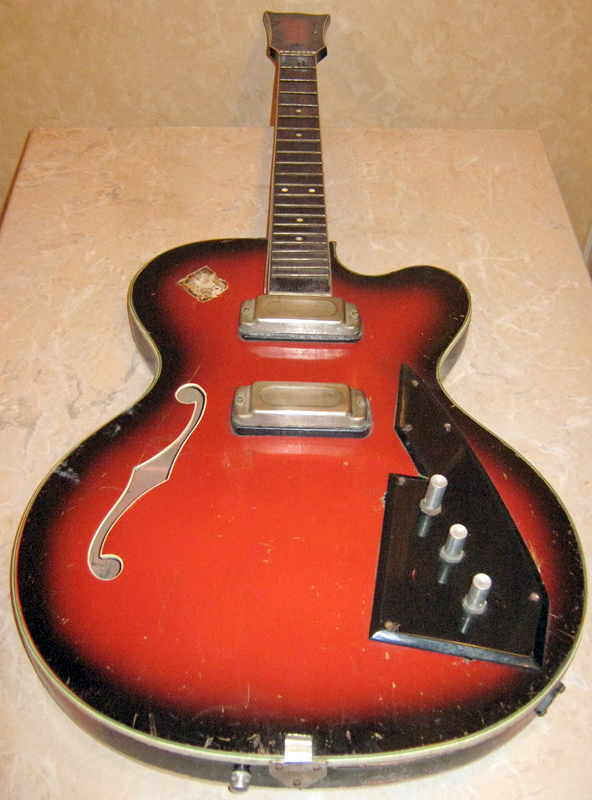 No. 1 – Early 70’s, exact date of production unknown 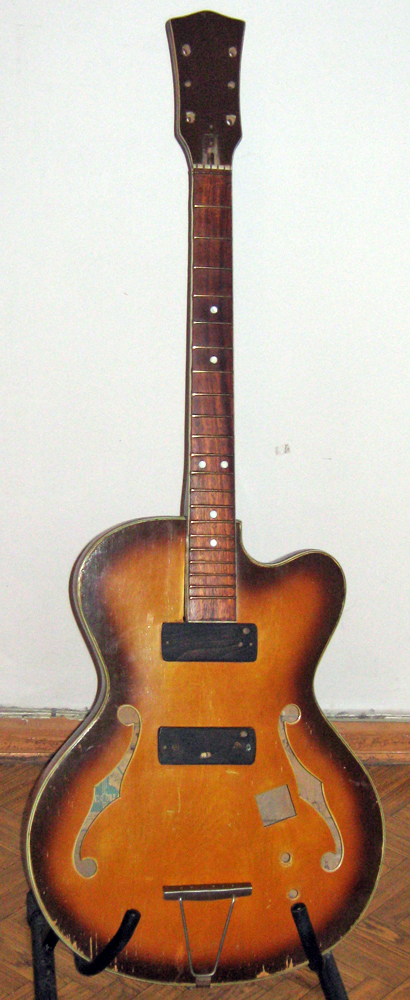 No. 2 – April 1975 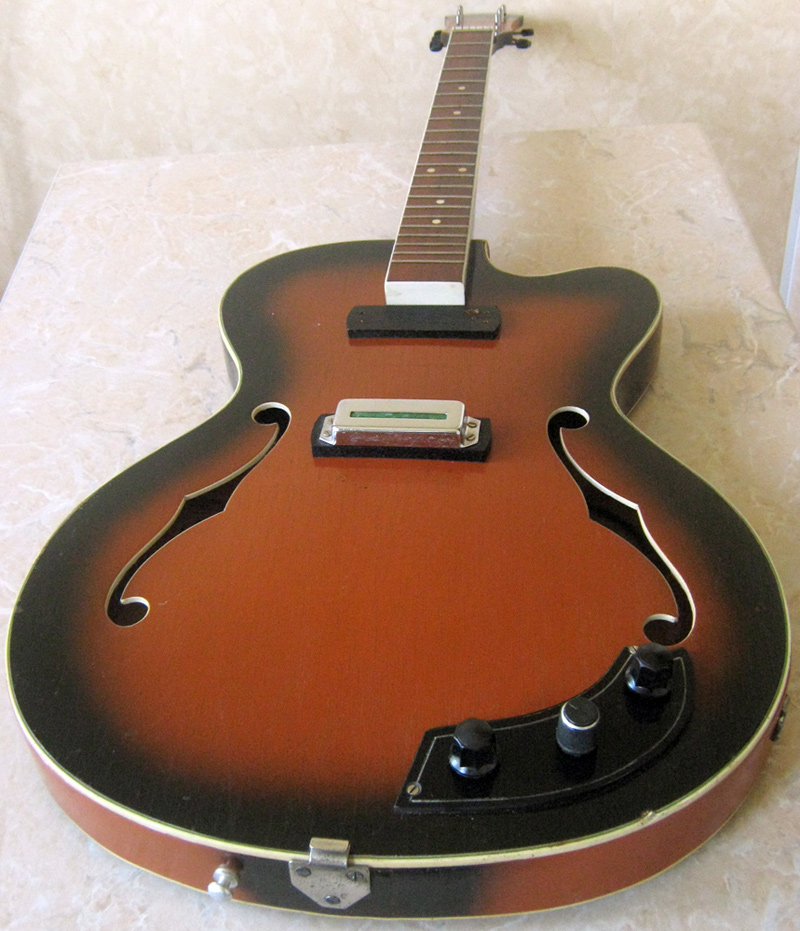 No. 3 – June 1979  No. 4 – 1981 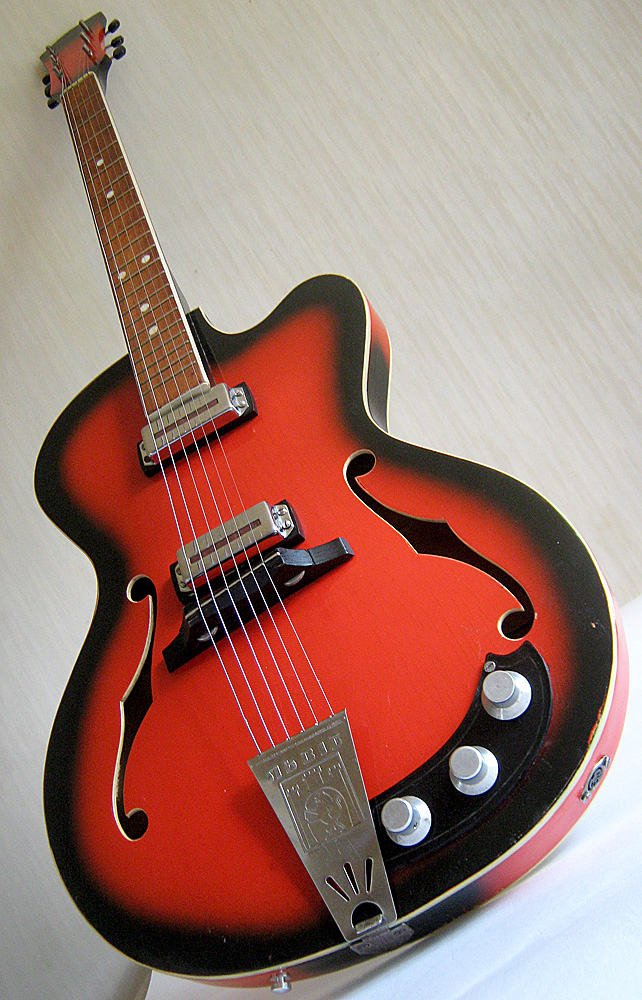 No. 5 – March 1982 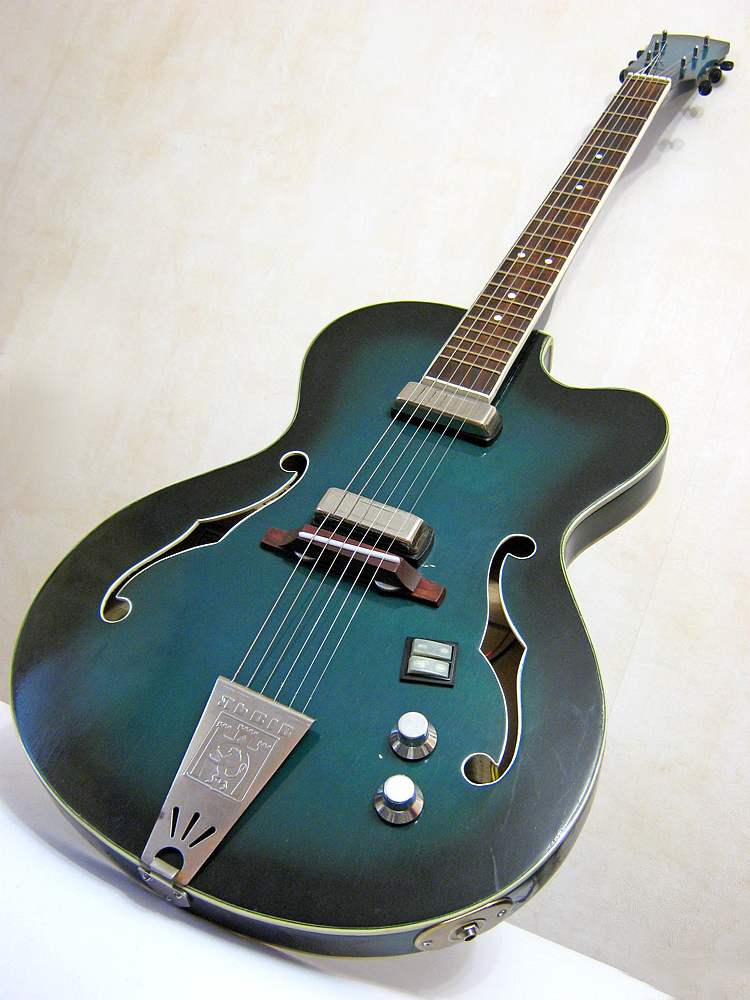 No. 6 – September1985 For a more graphic comparison, I have positioned the six images side-by-side and in chronological order for the following result: 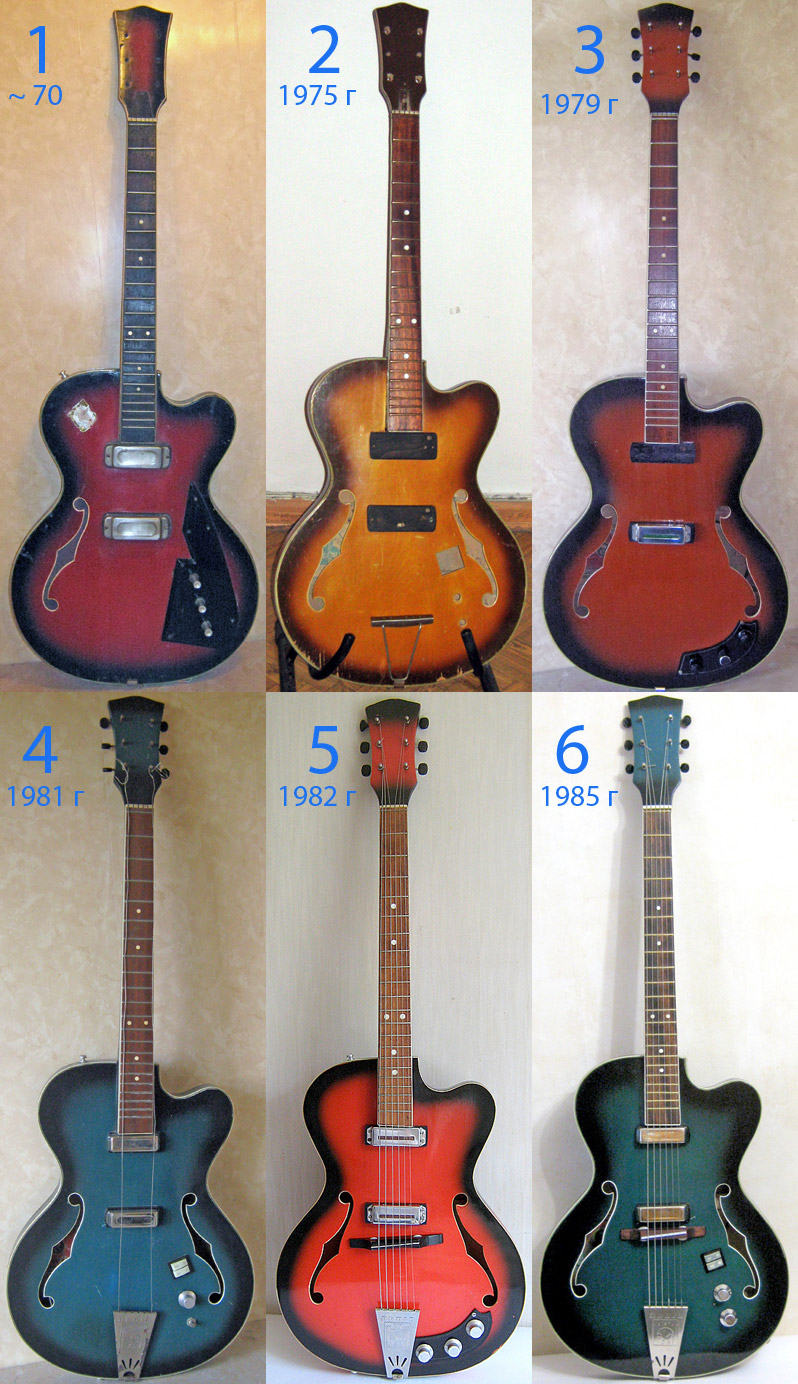 After such a comparison a certain pattern begins to emerge. At present, I see two distinct design styles as well as two periods when these options were being produced. I’ll volunteer a guess and call these two designs “standard” and “deluxe”, respectively. This designation obviously is based on some assumptions; however, it should simplify classification. One of the arguments against this tentative nomenclature is that all the design styles throughout the entire production period came with the same price tag of 185 rubles. Let’s examine the images and see which category each of the numbers falls into: Standard option: 1 - early; 3, 5 - later. Deluxe option: 2 - early; 4, 6 - later. Notably, controls on the standard option never include a switch and are limited to volume and tone pots. This option always has a pickguard that these controls are mounted on. 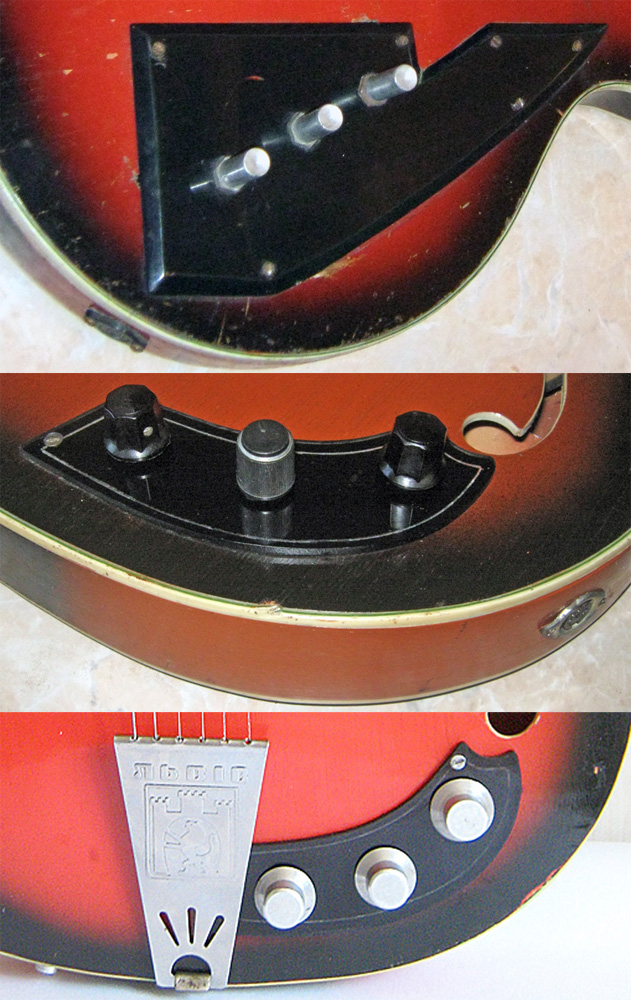 The earlier examples of the standard option came with a black-stained fretboard, the later ones unstained (the fretboard the deluxe always came unstained). The fretboard is a fairly thick slab of mahogany or some fruit tree. 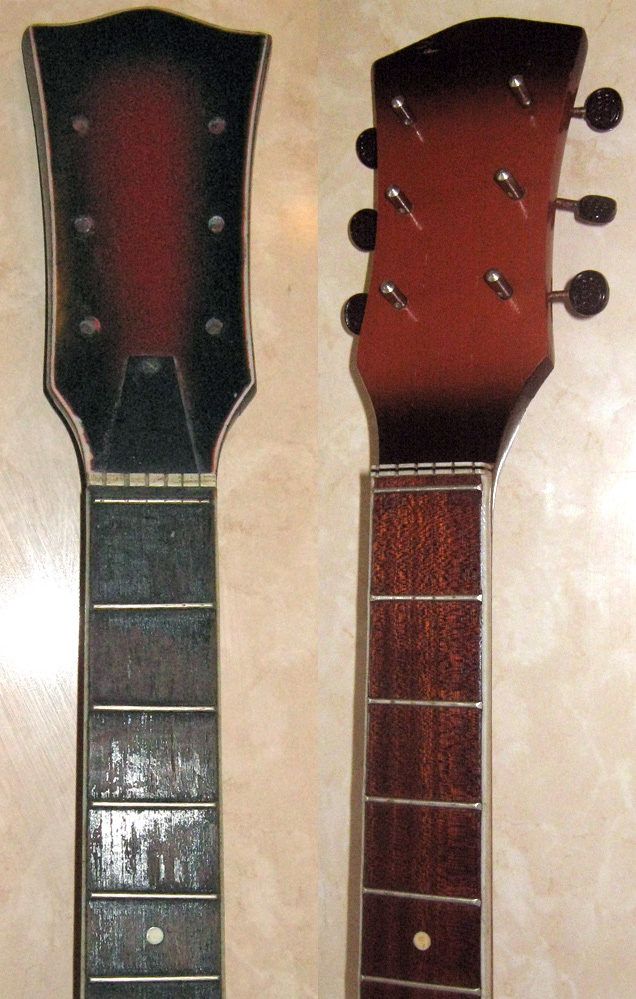 Another feature that distinguishes later modifications of the standard option is that they did not have a truss rod. The earlier standards did. 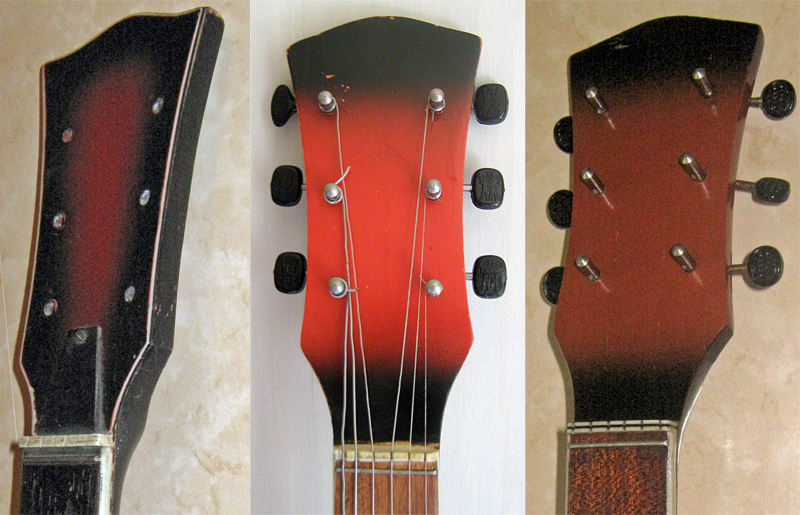 One feature that makes all the modifications of the deluxe option stand out are the controls; both early and late deluxes have a pickup switch, one volume and one tone. The deluxe option did not have a pickguard and had controls mounted directly on the body. 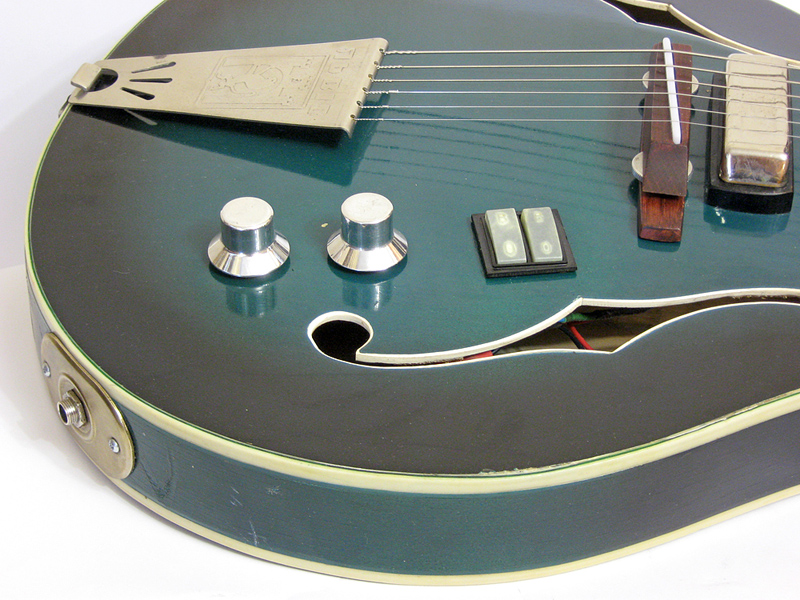 Just like the standard, the deluxe options have different neck designs across the model range: the earlier models had a truss rod and the later ones didn’t. The fretboard on both the early and the late deluxes had unstained mahogany/fruit-tree fretboards.  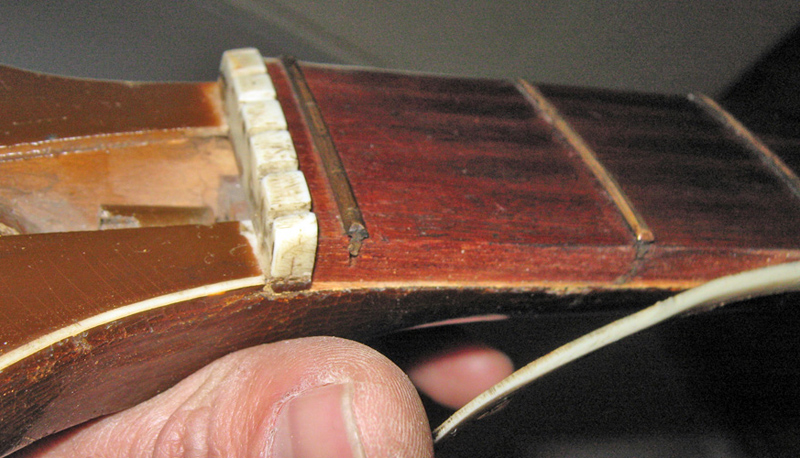 Earlier deluxes had plastic headstock purfling not available on later models. 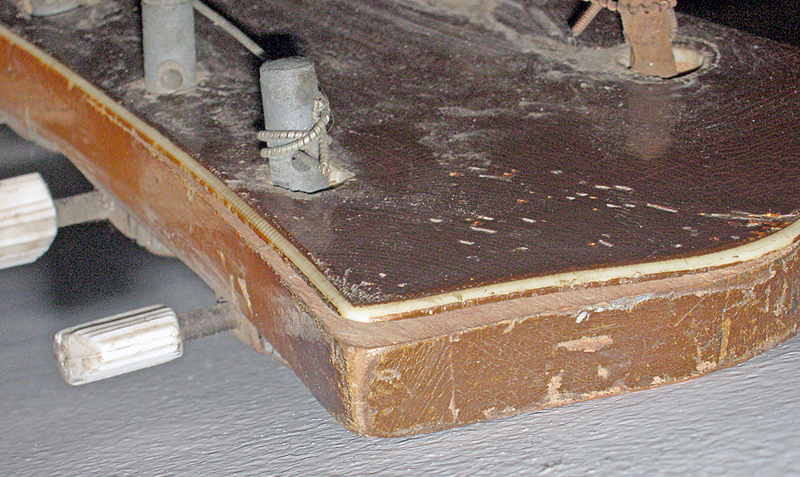 Also, there is some variation in the pickups, which are the same large-sized chrome-housed pickups with six separate coils on both the early standards and early deluxes. Mounted on a black stained wooden baseplate, the marking on the back that reads: production date, Minpribor (Ministry of Instrument-making, Automation Equipment, and Control Systems – translator’s note), ЗС-1 (Pickup-1) and price (12 rubles). 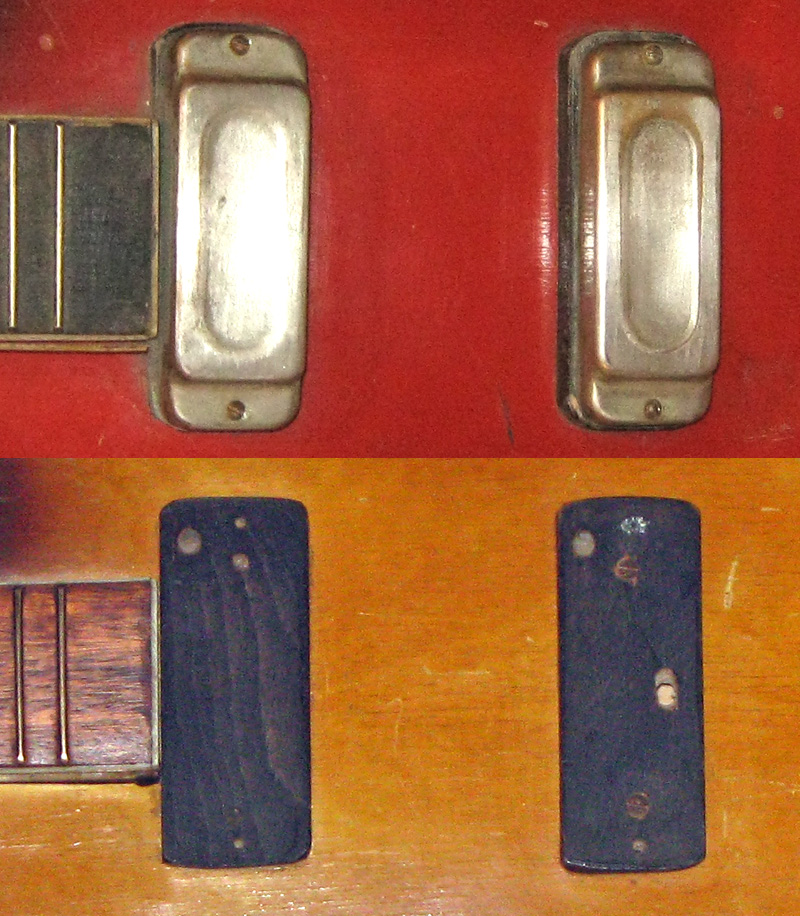 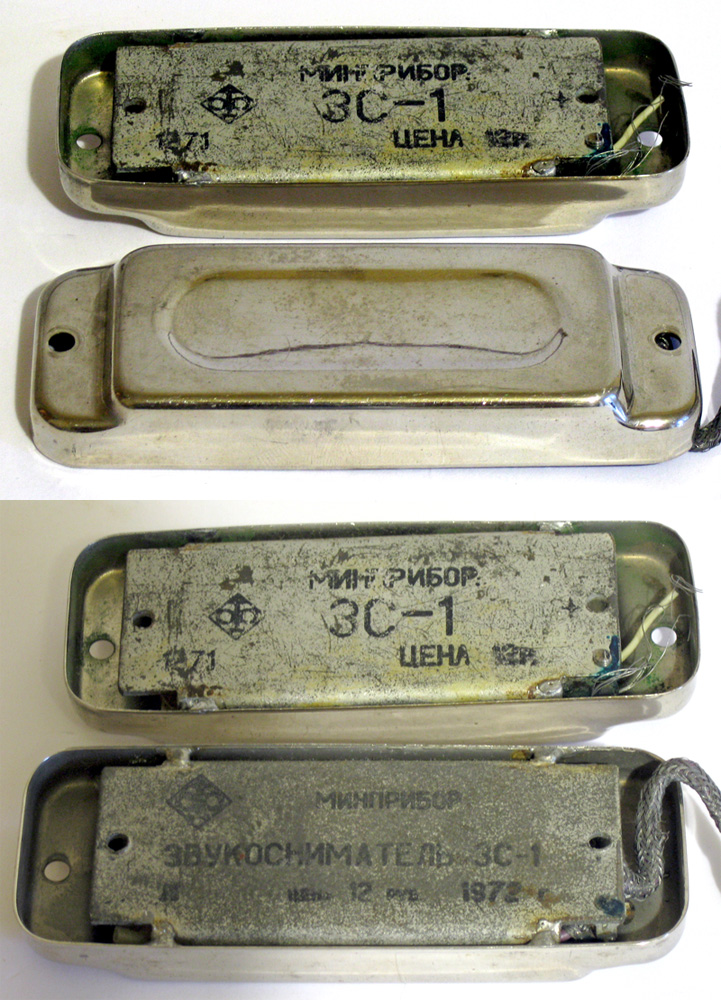 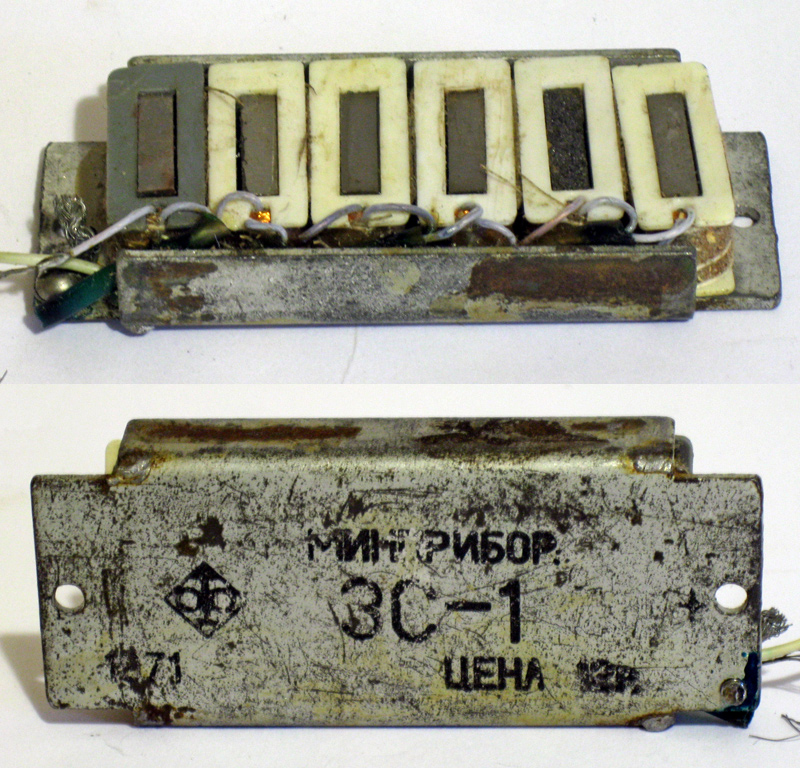 But on later options standards and deluxes had different pickups. The later standard option came outfitted with pickups that were mounted on a black stained wooden base plate using four screws, these pickups had a decorative pearloid plastic insert showing though a slot in the chrome-plated housing. We often see this pickup design on Belarussian Futuramas, Aelitas and, less frequently, Eltas. The marking on the back reads: the factory logo, production date and price (9 rubles). 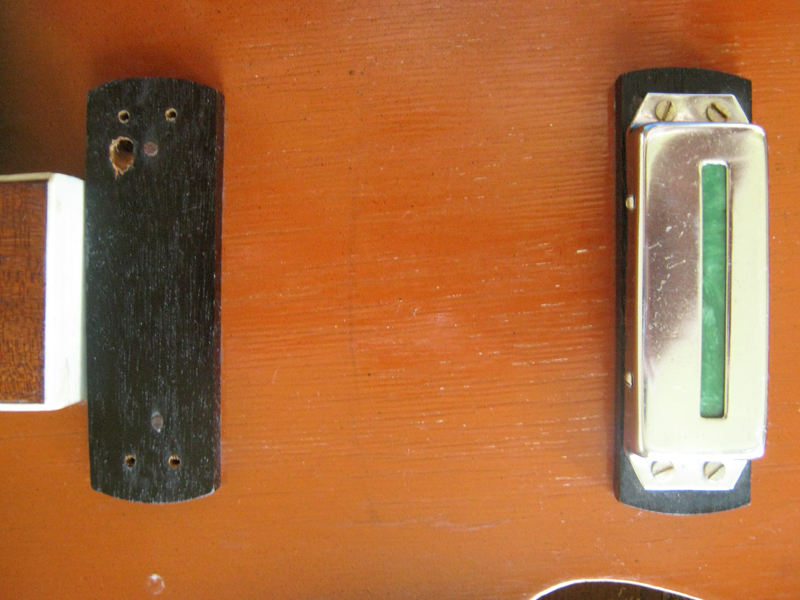 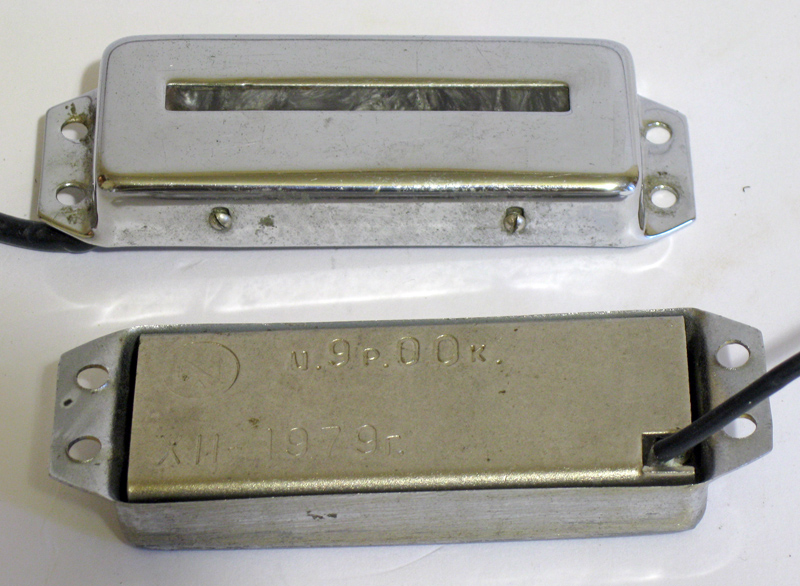 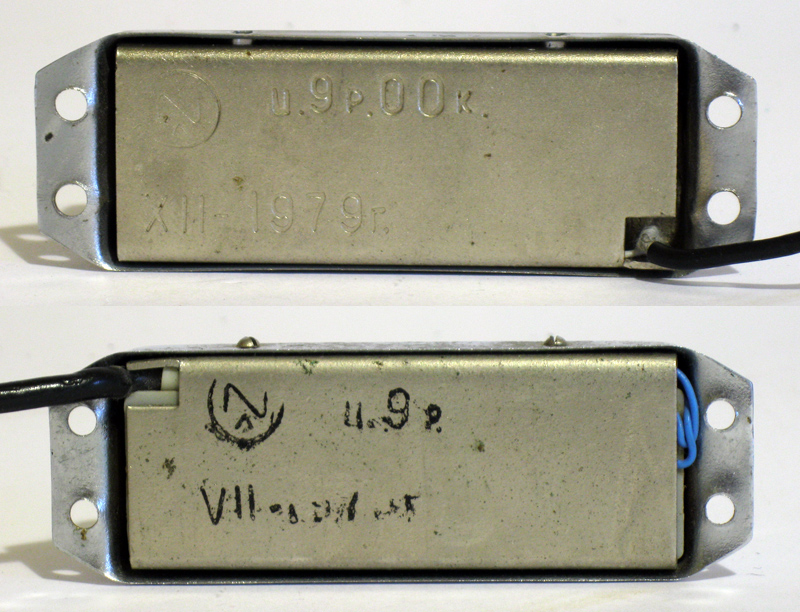 The later deluxes came with the kind of pickup that is sometimes found on Odessas and frequently on Eltas: these are mounted using two screws that are covered with a chrome-plated housing, no slot. Standard mounting via black stained wooden baseplate. The marking on the back reads: the factory logo, ТУ-25-11-290-69 (technical specifications) and price (9 rubles) 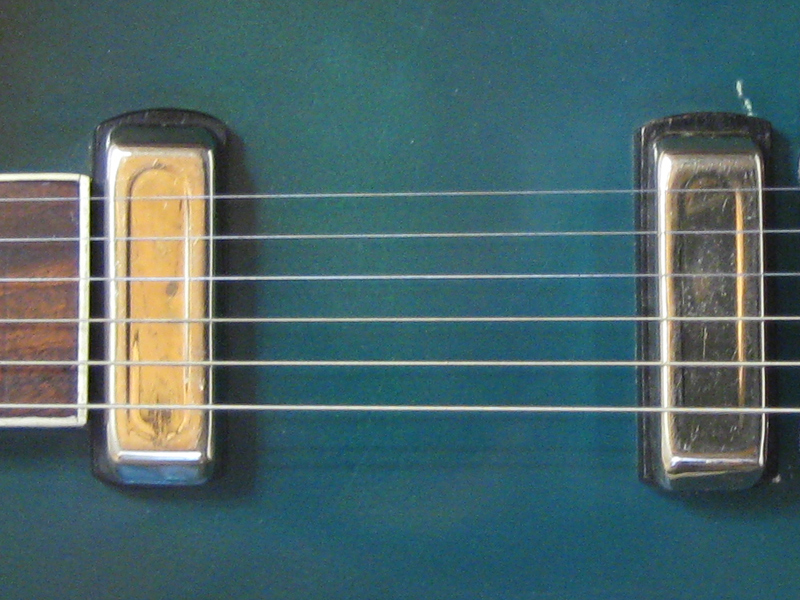 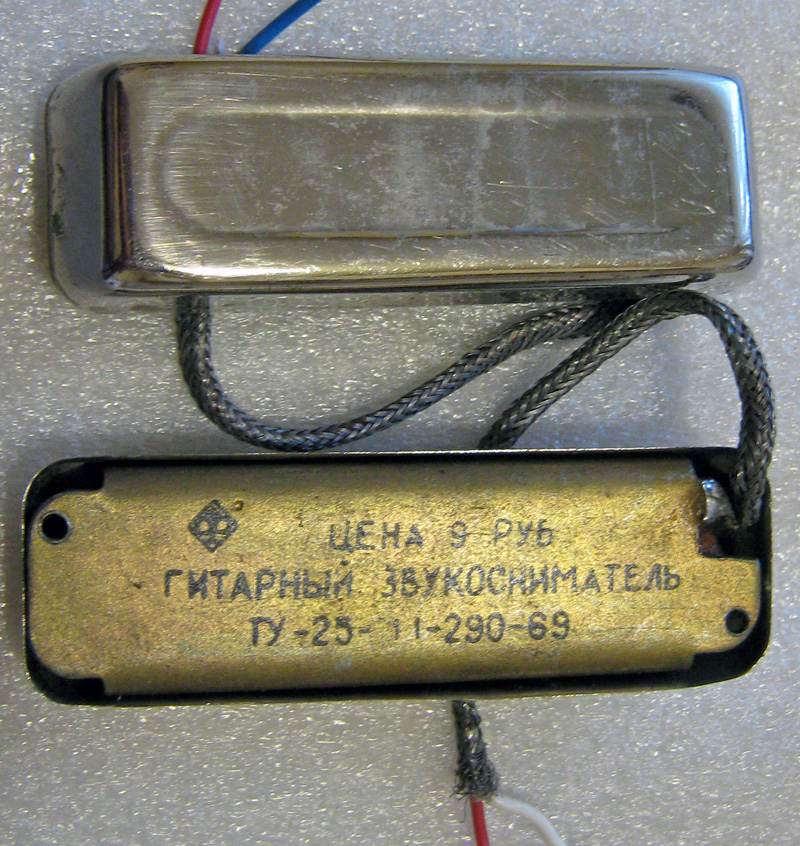 The tailpiece design is worth examining, too. The same type – an L-shaped string mounting plate with six string slots and a wire mounting bar – was installed on both the earlier standards and the deluxes. 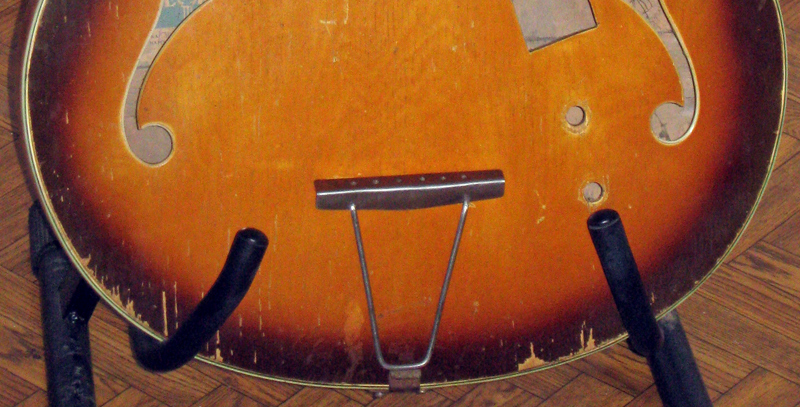 At first, the later models of both options appear to have the same type of tailpiece, a chrome-plated cambered plate with the Lviv city crest and the inscription “Львiв” (Lviv) stamped on it. But upon closer examination, we see that the deluxe option has an additional detail stamped – hammer and sickle – that is not there on the standard option. 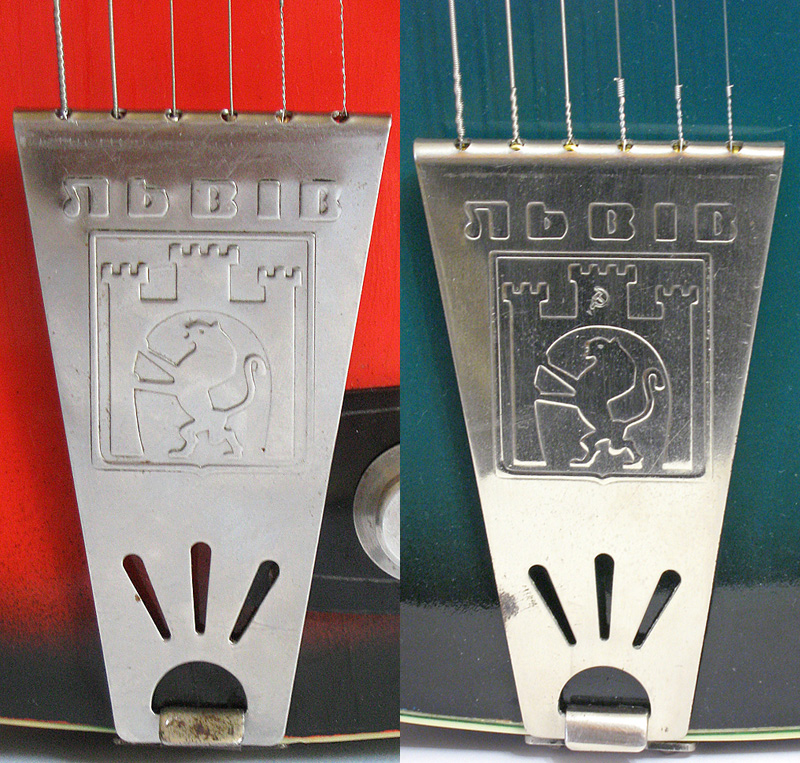 Allegedly, the body of the early standard had a sticker depicting the Lviv city crest. 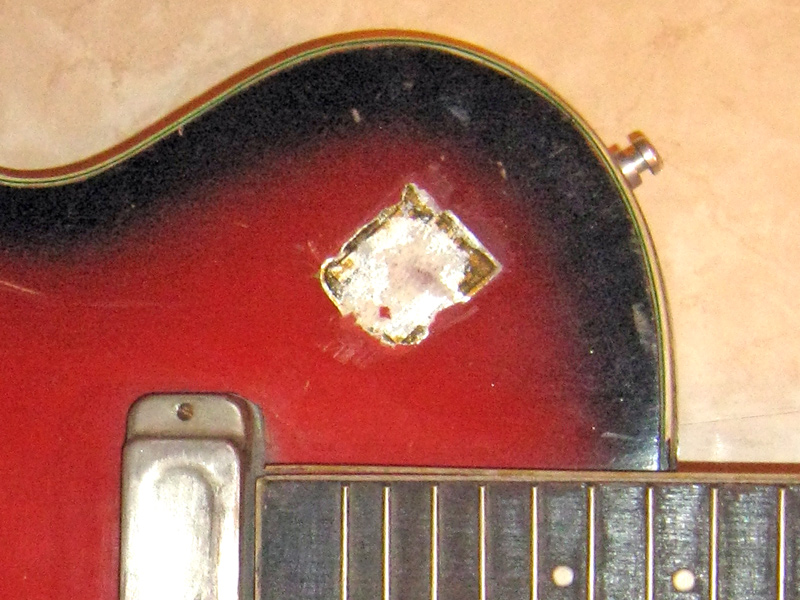 My guess is that the instruments that were produced during the later period had a simplified design. All the modifications are aimed at streamlining production process, doing away with the need to stain the fretboard, or install headstock purfling. Truss rod is gone. A solid (rather than a two-piece) tailpiece – anything to reduce labor costs. The guitar cost reduction is also obvious in the pickups that are less complex and not as expensive as the ones that the earlier models were equipped with. Before we move on to Part 2 of the article, let’s briefly summarize the features that are similar for all the models, to be examined in greater detail based on specific examples in the next section. Plywood, bound body. 3-ply binding on the soundboard with the central section invariably green, regardless of the finish of the instrument. The back, the neck and the f-holes are bound in 1-ply white plastic. The finish is always sunburst, various colors. Floating wooden bridge, adjustable for action. The neck is always attached using three screws, covered by an upturned trapezoid-shaped neckplate. The truss rod models had a similar shape truss rod cover. The tuners used were similar to the ones on the Lviv-made acoustics. Often their design varies somewhat but it’s always the open type tuners. The 3X3 tuning machines are more common than separate tuners. More likely than not, it was a matter of what was available at the moment. No threaded bushings. All models had machined aluminum strap buttons that were threaded and screwed into the body. The lower strap button is consistently positioned off-center and towards the upper bout to make room for the center-positioned tailpiece. Part Two Let’s focus on a later period deluxe and examine it more closely. This particular instrument is dated September 1985. The guitar is fairly pleasant too look at. But the quality of both the production and the assembly of multiple nodes leave a lot to be desired. At closer inspection workmanship flaws become apparent. Then again, this is something that’s applicable to all USSR-made guitars to various degrees. 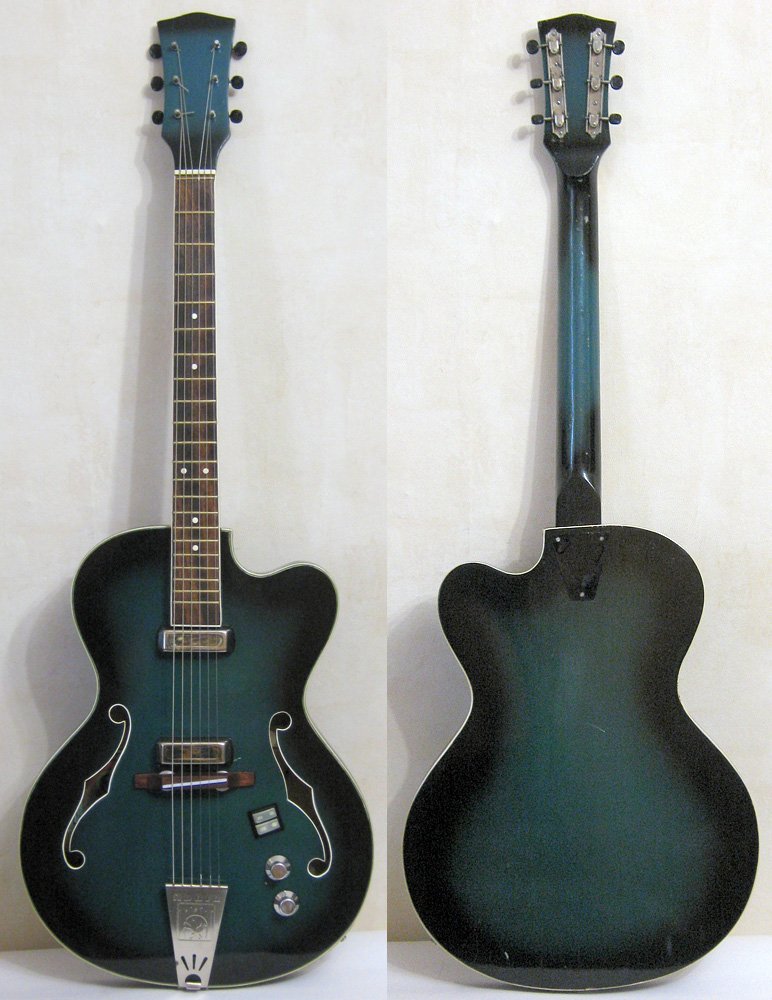 The Body The body of the guitar is made from 3-mm plywood. It has a 3-ply white/green/white binding on top, and a 1-ply white binding on the back and the f-holes. Notably, the f-holes are mirror-like in relation to each other. In other words, usually the upper f-hole is S-shaped. In the case of the Rhythm, it’s a backwards “S”. It’s like the upper and lower f-holes switched places. I wonder if that was done on purpose? The guitar’s finish is the customary sunburst but the center color is a fairly rare bluish-green or turquoise. The pickups, controls, tailpiece (a chrome-plated steel plate) and the bridge are mounted on the body. Floating wooden bridge, adjustable for action. 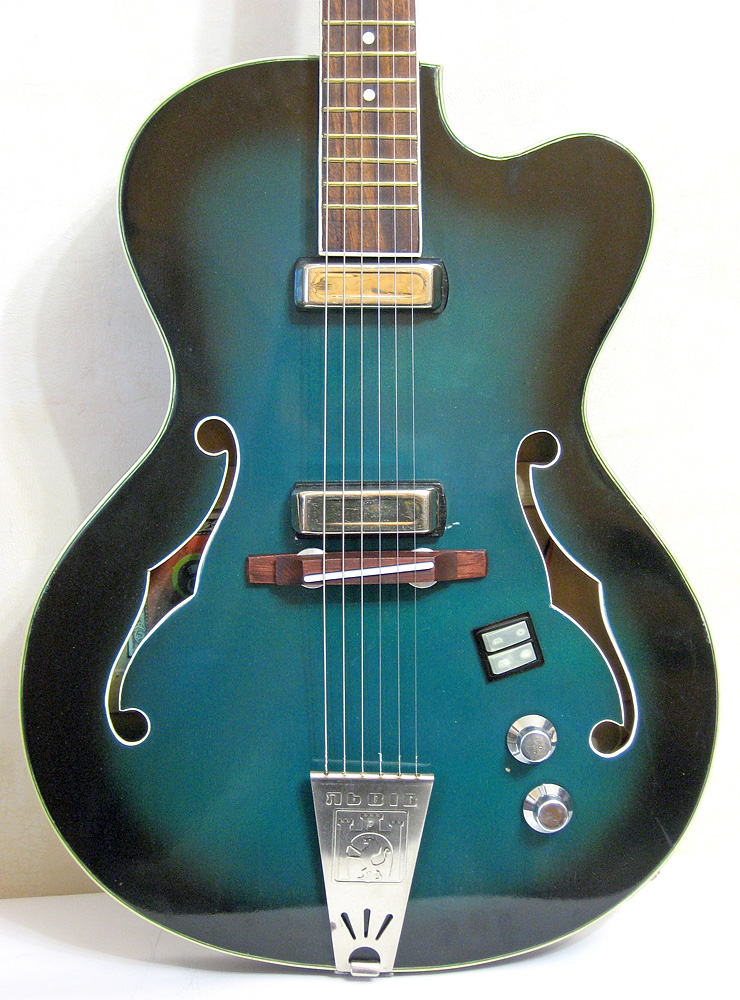 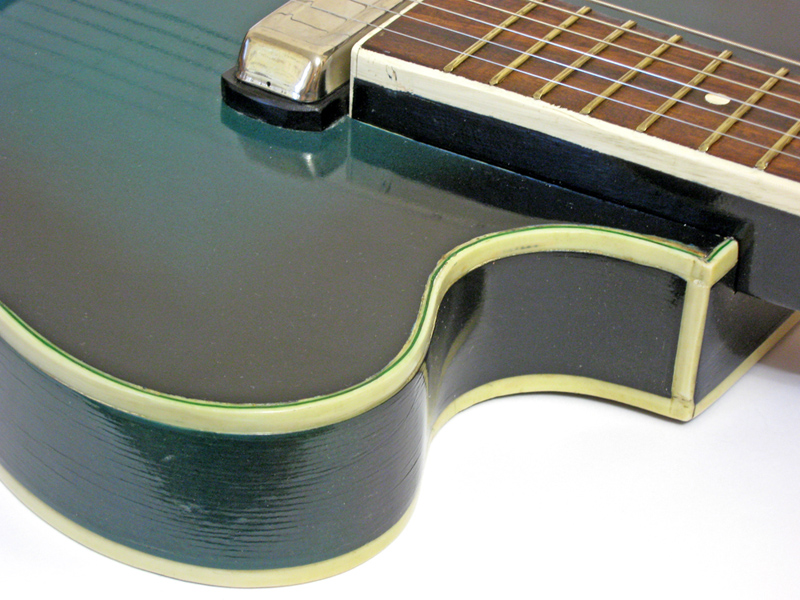 If we remove the neck, we get a better look at the body design. Take a look at the neck joint: both to the left and to the right of it, there are two front-to-back struts and the clearance between them and the soundboard gives a good vantage point of the body interior. 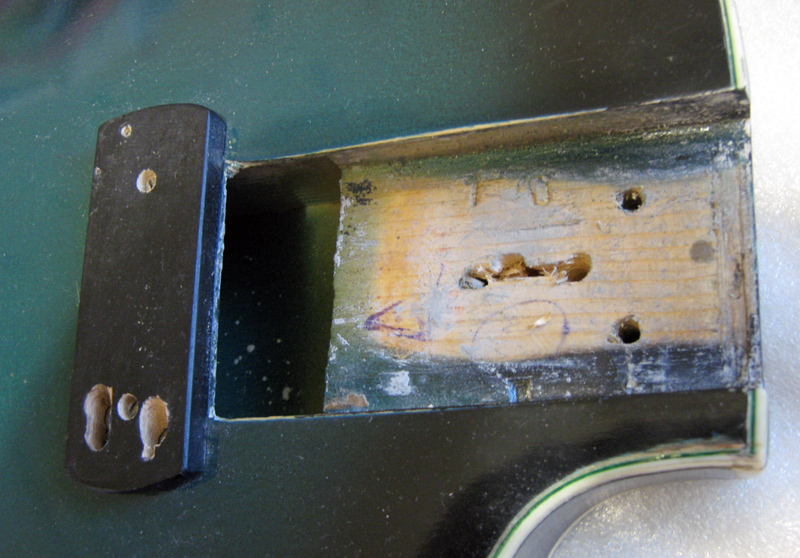  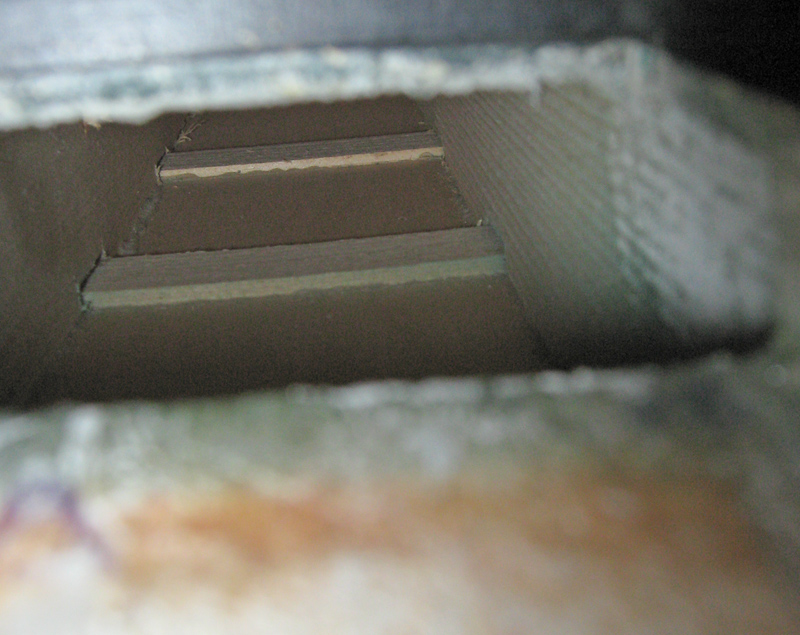 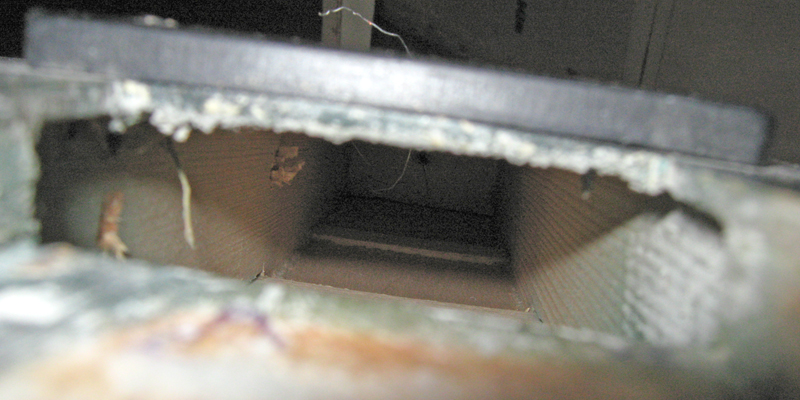 The braces on the top and the back run across the length of the body. You can also see that the body is divided into three cavities. In the central part you can see the grounding wire that is fed to each pickup via the wooden baseplate.  The neck The neck is fairly bulky and thick. No truss rod. Since it’s so massive, the neck is straight. 3-piece beech. Attached to the body with three screws covered by a trapezoid neckplate. 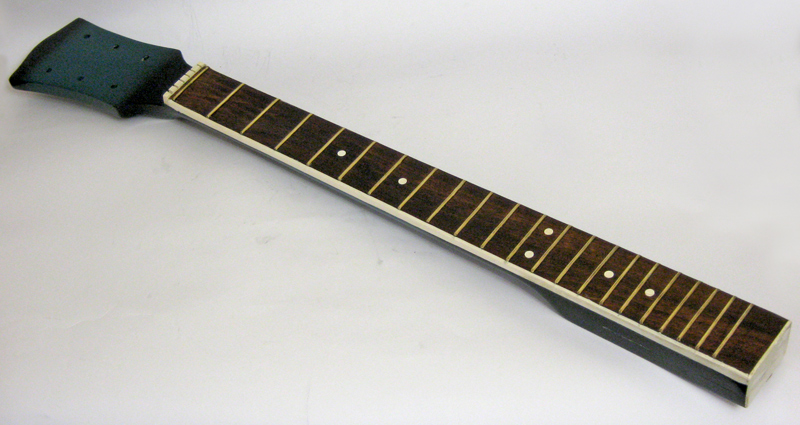 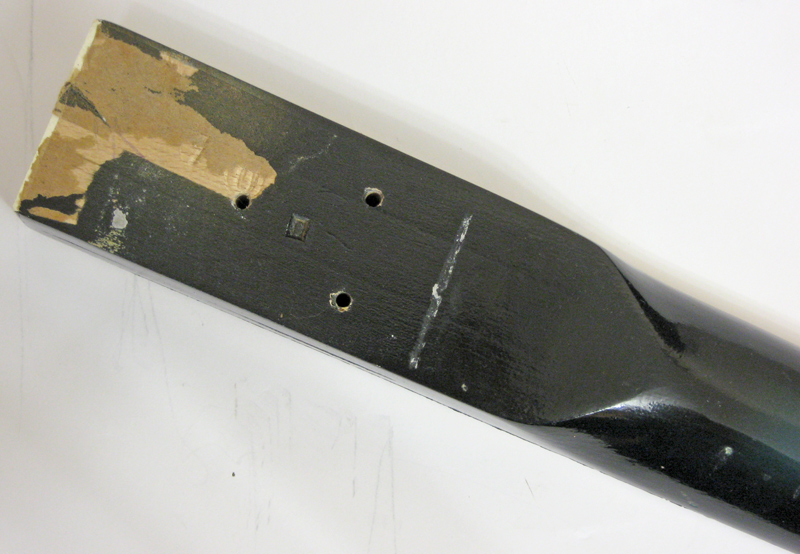 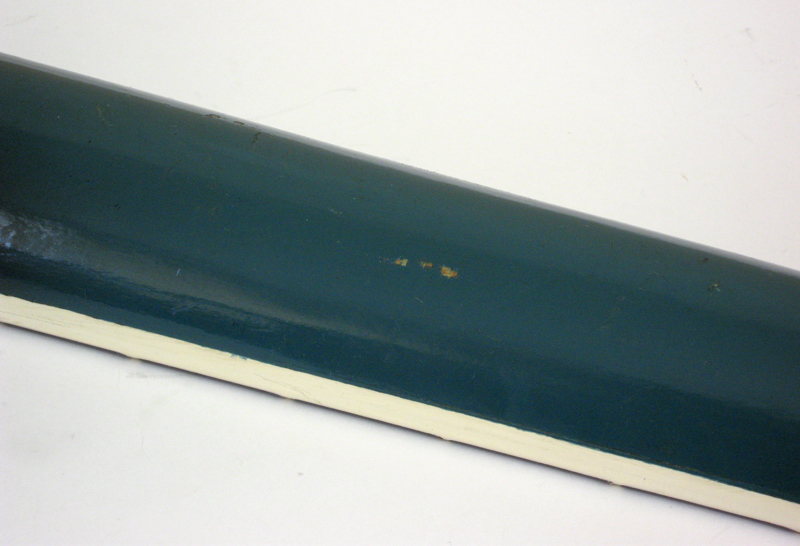  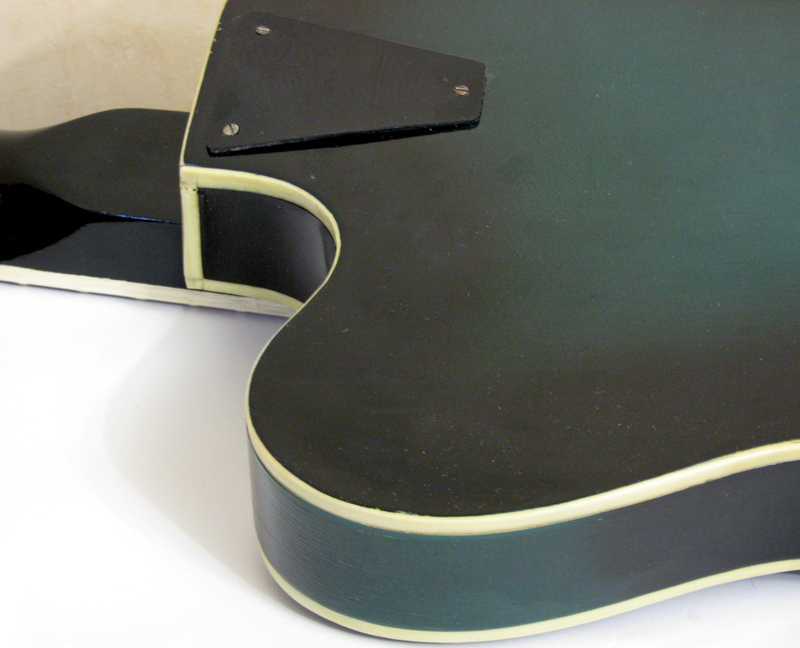 Thick mahogany fretboard. White binding. 21 frets plus zero fret. This particular instrument has bronze frets. The fretwire quality and the workmanship are fairly low; the frets are not neat to begin with plus the installation is sloppy. 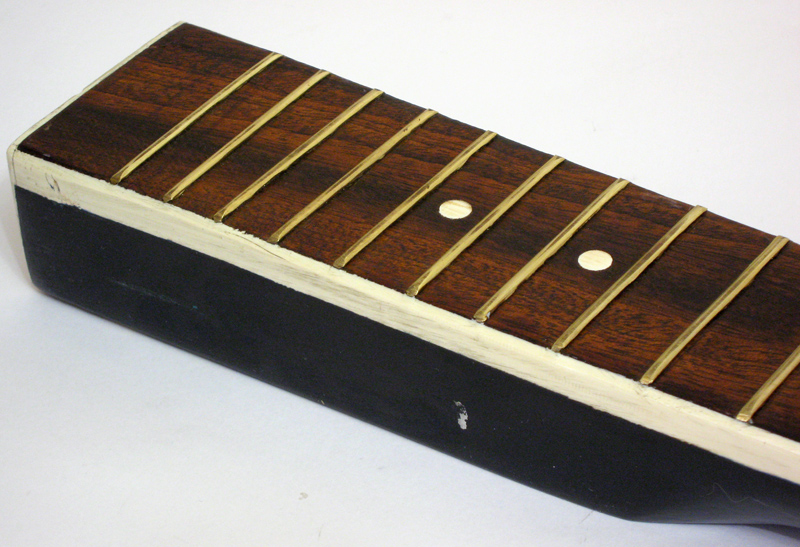 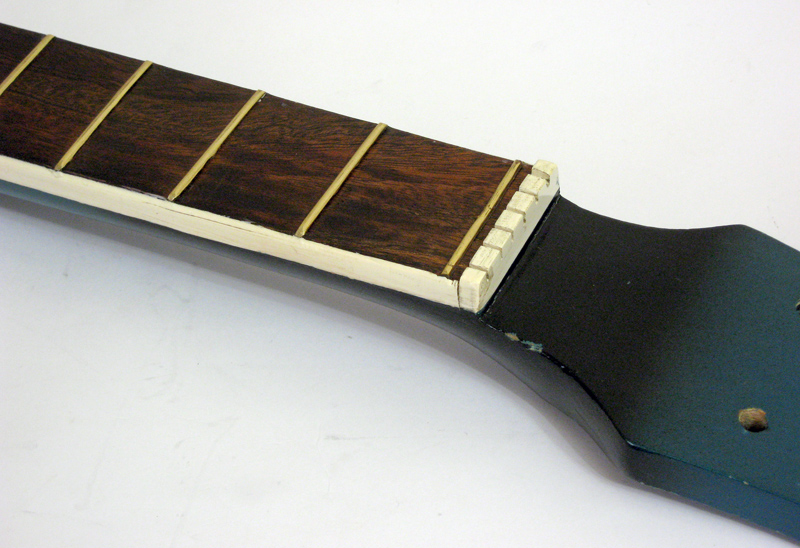 The 3X3 tuners on a plate are the type often seen on acoustic guitars. No threaded bushings. 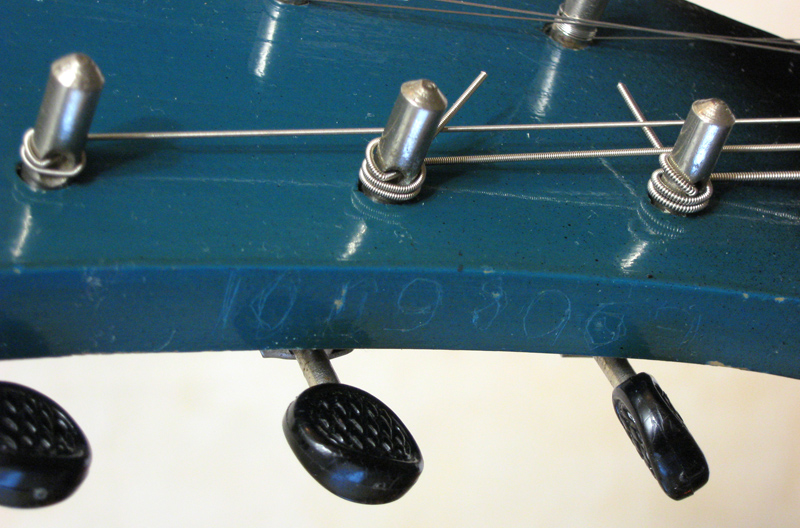 Electronics The circuit is fairly basic which, you must admit, is seldom the case on Soviet guitars. It includes two pickups, а pickup switch, one volume pot and one tone pot. The output jack is supposed to be a DIN-5; unfortunately, on this particular instrument, it has been replaced with a jack (a sloppy job at that). 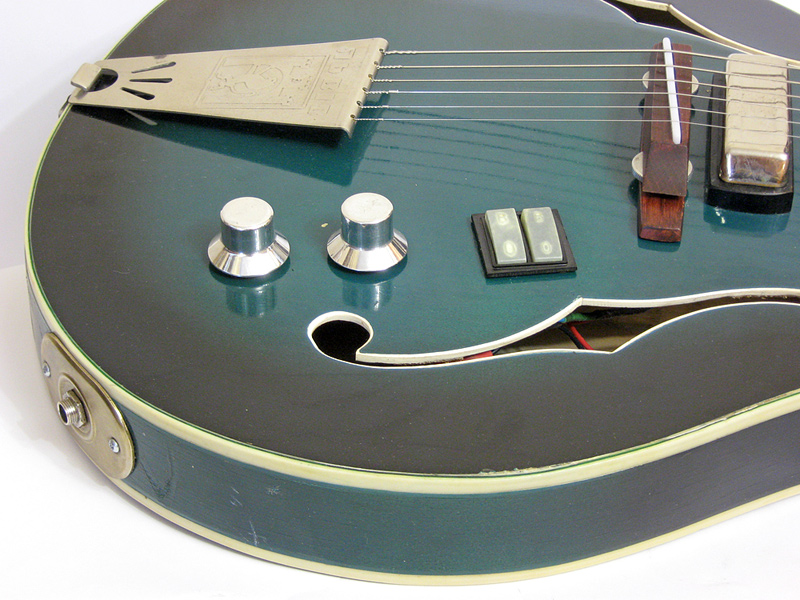 The aluminum knobs use one set screw and are standard for all guitars made in Lviv. The switch is the most interesting component and it’s worth talking about a little more. On the outside it looks a lot like what was used on the Odessa guitars but the design is somewhat different. It seems smaller. Also, the manner in which it’s attached to the body isn’t apparent after a quick examination: there is no mounting hardware. But then you look at it more closely and it becomes crystal clear. Let’s take a look. In an attempt to understand how it’s installed, I tried to feel inside the f-hole for any mounting hardware. It was easier than I’d thought – the switch started coming loose and moving upwards. No fastening device of any sort. It’s held in place due to friction. An unusual decision, though somewhat dubious. 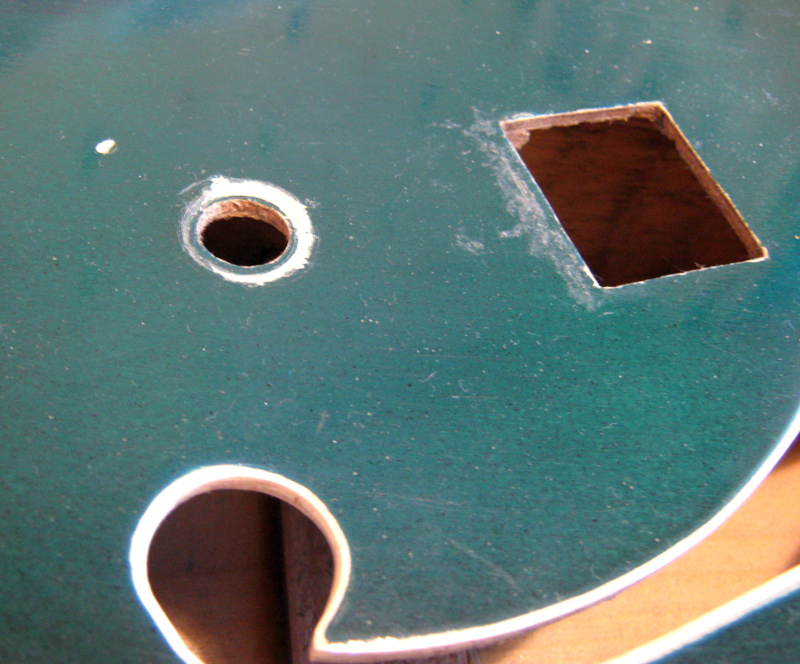 Let’s take a closer look at the switch. 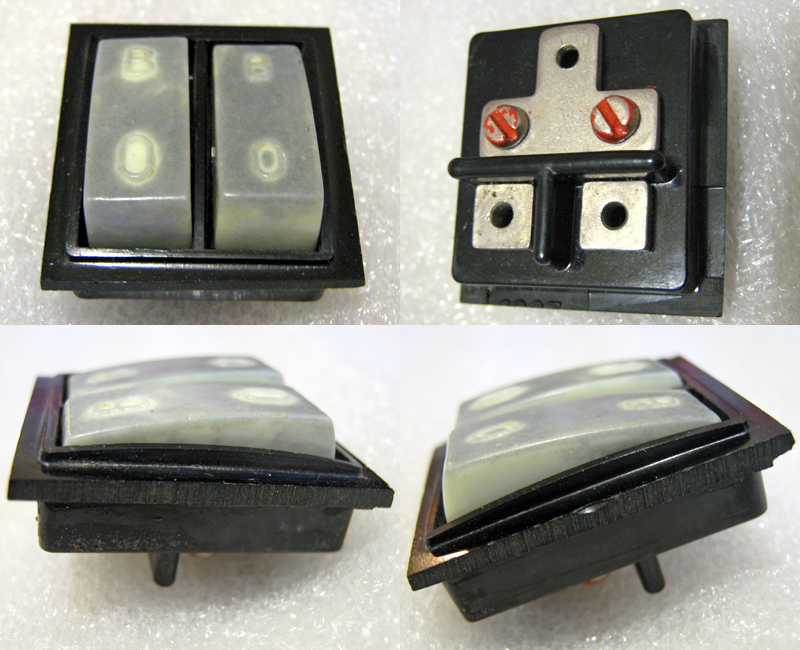 The trimmed and shaped edges are an immediate attention grabber. The evidence of alterations are the cut-off markings and what little is left of the mounding hole. It’s the same switch as the one installed on Odessas, after all. Let’s place them side-by-side for a more graphic comparison. 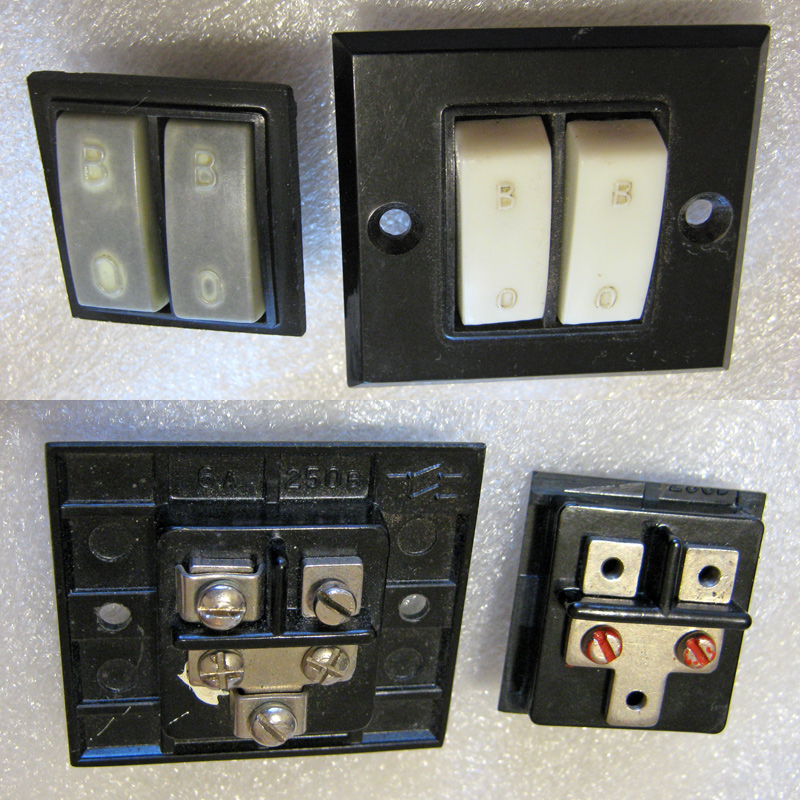 It’s not exactly the best production practice to have to trim the edges of each individual switch but that is precisely the case here. Like on Odessa, the buttons are phosphorescent but since they are factory-painted a translucent gray, it’s only the outlines of the letters “B” and “O” (marking “On” and “Off” positions – translator’s note) that become visible in the dark. It must also vary from lot to lot because I have seen Rhythms with buttons that were unpainted. Here’s a curious factoid regarding the switches that could be useful for those who may be restoring a Rhythm or an Odessa. When visiting various marketplaces and flea markets that sell buttons and such, I always kept an eye out for these switches. And then recently It dawned on me that more likely than not, I just didn’t see them. It’s pretty simple: the Odessa switch is a component of a household light switch that comes in a housing. The way I expected it to look when I searched for it, I never came across it. And a light switch assembly is easy to walk right past. But then you disassemble the housing and get exactly what you need. 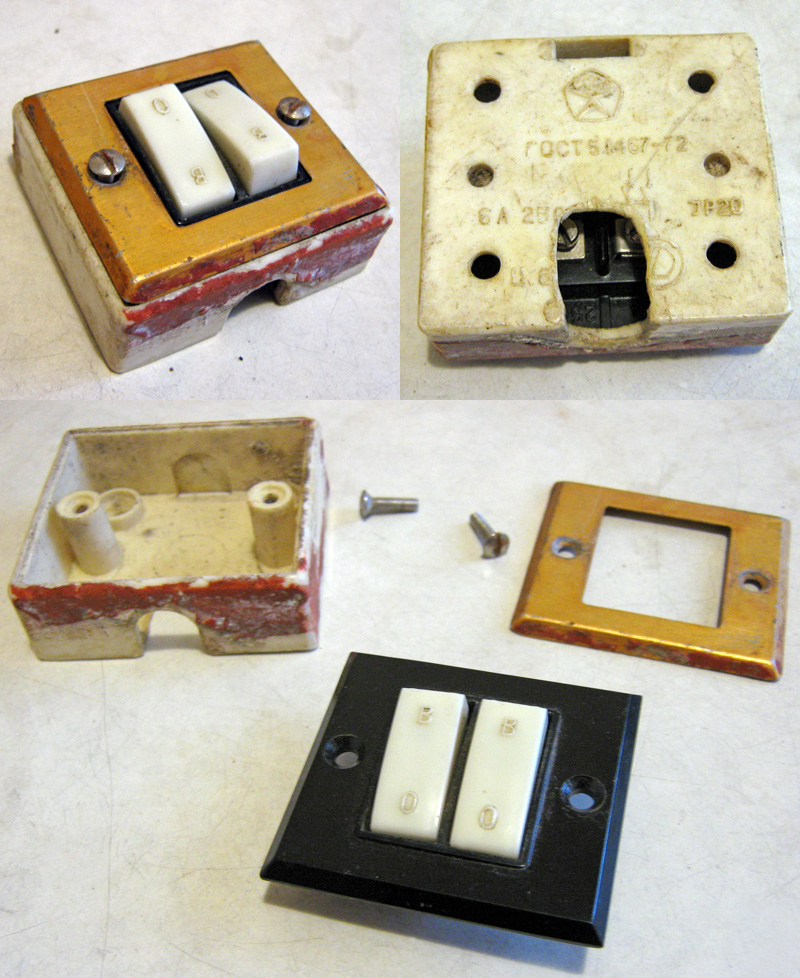 In conclusion, here’s a sound sample of the guitar, recorded directly into a line-in, using DOD GATE/LOOP FX30-B noise gate and a Behringer MIC 200 tube pre-amp. Listen to the sound sample: http://www.sovietguitars.com/e107_files/images/Lvov_Rhythm/Lvov_Rhythm.mp3 Roman Volkov 09.10.2010 Translated by Ilya Shlepakov, 2011 © [ Редактирование 23.03.2011, 16:43 ] Ваше шило, наше мыло: [link] [link] | ||
| Наверх |
|
| Модераторы: violet, EjiK, Басист Кайф, Я-Ха, Izol, SPA, shlepakoff, byte_crow |
Powered by e107 Forum System
| Мини-чат |
Вы должны войти, чтобы отправлять комментарии на этот сайт - пожалуйста, либо войдите, либо - если вы еще не зарегистрированы - щелкните  Skyworker79 Skyworker7915.04. : 15:30 Надеюсь,кто то из форумчан успел приобрести и мы увидим хорошие слайды! [link] Посмотреть все сообщения (118948) |
| Поиск Советские гитары |
| Счетчики |
|
|
© 2006 - 2024 SovietGuitars.com - Общество Коллекционеров Советских Электрогитар. Сайт не является СМИ. 18+
Техническое обслуживание сайта осуществляется веб-студией «Код-А»


